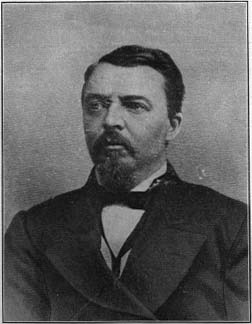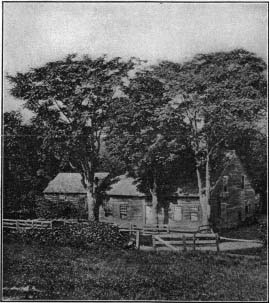|
Sketch of Holyoke by George H. Allyn, page 8 I have often thought that St. George, attacking the dragon, and Leonidas sending defiance to the three million Persians, were poor and weak compared with the defiant courage of little "Mickey" Lavelle. In 1872 came H.B. Lawrence to this school, and what he was to the youth of the city cannot be fitly related. Teacher from the crown of his head to the soles of his feet, he fairly drove education into his pupils, and inoculated them with the fever. Not a scholar but knew that the best and greatest favor he could do Mr. Lawrence was to make rapid progress in learning. The dullest and crudest would probably expand under his care until the result would be almost unbelievable. If Holyoke ever erects a Hall of Fame there should be inscribed, high up on the scroll, simply, "H.B. Lawrence, Teacher," and some of our presidents have earned less of real honor than that symbolized by the one simple line. By 1870 Holyoke had gone ahead splendidly; the old Albion Paper Company had been formed, the new Prentiss Wire Mill on Dwight street, and the Crocker No. 1, and also the Union Paper Company (succeeding the Bemis) established, the Holyoke & Westfield railroad projected, the Riverside Paper Company had been organized and a mill built back in 1867, and the population. had increased to 10,733, a figure no scholar of those days ought ever to forget, in view of the way it was drilled into us. There was steady work, and plenty of it. The spirit of hustle and success had pervaded the bustling town. We had no suburbs really worthy of the name, no Highlands (save the Manchester Grounds), and the most pretentious house in the Highland section was George C. Ewing's brick mansion on Dwight street, erected a few years before.

Dr. J.G. O'Connor.
The want of an adequate water supply held suburban development in a vice. Several nice residences had been erected down town, and more were planning. In the next few years the fine William Whiting, James H. Newton, R.P. Crafts, George W. Prentiss, and others were built. It was not till 1869-70 that the water question was keenly agitated, and August 2, 1871, a citizens' committee was formed, comprising Messrs. John C. Newton, Timothy Merrick, W.B.C. Pearsons, and others, to see what could be done. An awful season of drought set in that year, the pumping machinery of the reservoir works broke down, and the writer will never forget "hoofing it" down to the river bank, where there were some nice, cool springs, for pails of drinking water, while the domestic supply was teamed up the steep grade from the sawmill in barrels. C. Waldo Kelton, who drew a lot of it when he worked for the writer's father, always maintained that the horse he used went blind afterwards because of the terrific pull up the steep grade. The Manchester Grounds at that time were supplied from the Mt. Tom Aqueduct. Company, whose spring was in the rear of the Wakelin residence, about 400 yards to the northwest, but that also failed, and water was hawked through the streets in barrels. Holyoke's most hardened "soaks" realized the need of water that season. After considering five plans the taking over of Ashley and Wright ponds was determined upon, the necessary legislation secured, the first water board comprising Judge J.P. Buckland, W.B.C. Pearsons, John Delaney, Dennis Higgins, Joel Russell, and John E. Chase chosen March 21, 1872, bonds to the amount of $250,000 issued, and the work begun. The ponds comprised a flowage of one hundred and eighty-five acres, had a water shed of three and one-fourth square miles, and were promptly acquired with the land immediately adjoining. Then came the question whether a branch main should be laid down Northampton street to the "Manchester Grounds," or whether it should be left for a later day. The Water Power Company, though most liberal in its policy toward incoming manufacturers, was dog-in-the-mangerish toward owners of outlying land. The Manchester Grounds extension would bring the George C. Ewing, the J.F. Allyn, Edwin Perkins, and R.M. Fairfield land into demand. and the company fought the extension with the utmost bitterness, using the same arguments which recently obtained against the Smiths Ferry extension viz.: That the income from consumers woudn't warrant the expenditure. But we had big men in those historic days and the extension was promptly determined upon. Even before the work was completed, on August 6, 1873, the land boom started. James F. Allyn built a beautiful residence on Pleasant street, where before there had been but three houses, one small one just south of where the First Congregational Church now stands. A small house at the corner of Pleasant and Dwight streets, occupied by J. F. Sullivan, and a little house nearly opposite where lived a German named Wagner. This worthy man started in what we would now call the express or parcel delivery business, but in those days the vehicles were called "job wagons." The Teuton proceeded to letter the wagon himself, and, to the infinite delight of all the unterrified youth, he spelled it: "Gob Wagon." The Transcript hilariously commented upon it for a week or two, and the small boys nearly suffocated with their emotions, till some kindly spirit told the Teuton where the trouble lay, and the next issue of the Transcript announced that the "Gob Wagon" had "gone to the paint shop for repairs." Lots on Pleasant and Pearl streets went like hot cakes with the prospect of water, and the territory nearly all changed hands on paper, most of the buying being speculative. Then came the terrific panic of 1873, and most of the lots went back to be resold to genuine home-builders. The Holyoke Public Library was established May 16, 1870, W.S. Loomis being the king pin. The library was first in the Appleton street school, and the writer verily believes he drew the first volume from it, being promptly on hand at 2 p. m., when it opened, and, while he is prone to forget what happened yesterday or last week, he remembers to this day the name and number of the book, Mayne Reid's Boy Hunters, Shelf 73, No.93. If any old catalogue of the original library exists we should be glad to have our recollection tested. Miss Sarah Ely, the first and long-time librarian, was a remarkable woman. Not only did she have a phenomenal knowledge of what the library contained, but an intuitive knowledge of what appealed to the youthful mind. Her selection was almost magically attractive to all classes, and the writer used to wonder at the range of her mind. Some thirty years later W.S. Loomis inaugurated a movement for a new library. to which the citizens contributed most generously, and the Holyoke Water Power Company donated a valuable, central and sightly lot, so that the beautiful building on Maple street was completed and occupied in 1902.

Rand Homestead, Back Street.
In 1870-71 the commercial aspect of the brisk town had changed considerably. Main street was becoming a factor) quite a number of blocks Laving been built south of Dwight street during the 60's. David Adler was the first Jewish merchant we personally recall, he locating in 1867 or 1868, just south of the Hadley Falls bank, where George Attinger now holds forth. This section between Dwight and Cross streets soon became to be known as "Rum Row."
| Previous Page | Next Page |
| People & Organizations | Allyn's Sketch of Holyoke |
| Selected Advertisments | Churches | Surname Index |
© Laurel O'Donnell 1996 - 2005, all rights reserved
This document may be downloaded for personal non-commercial use only and should not be reproduced or distributed without permission. |